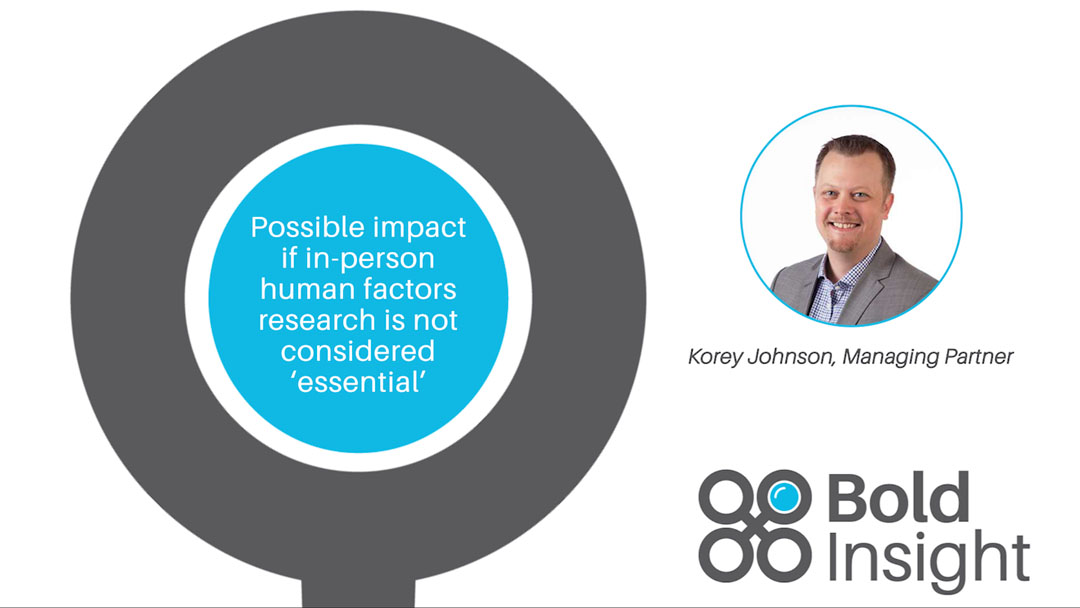How to continue to support development of safe and effective medical devices
Many thought pieces are being pushed out around what remote research methods are available to replace research that would have otherwise been conducted in person if not for COVID. We’ve published some ourselves (Three tips for conducting contextual research remotely and Pros and cons of remote moderated testing). Many tools are available, and there are plenty of research objectives that can be partially, if not completely addressed with these remote methods and tools. But as an industry, we should be viewing exploratory, formative, and summative human factors research that must be conducted to demonstrate safe and effective use differently than we view user research conducted for non-essential industries or for market research in general.
Weighing the possible negative impact on community health
With the elevated risk of person-person transmission of COVID, of course remote methods should be prioritized whenever possible in all cases. And priorities can also be shifted such that even for medical devices in ongoing development, documentation of use needs, use specifications, use-related risk analyses, and human factors plans can be prepared in advance of a return to the in-person simulated use testing still needed in many cases for validation of safe and effective use. But when those methods are insufficient, as is often the case for summative and even some formative medical and drug delivery device user research, the cost-benefit analysis of conducting in-person research needs to account for the fact that NOT conducting this research has a negative impact on community health outcomes in that the commercialization of new therapies and life saving devices is slowed.
The FDA has taken some important steps to ensure that development continues and is even accelerated for some product categories directly linked to the ongoing battle with COVID (e.g., ventilators, digital devices for treating psychiatric disorders, clinical trials). Similar steps should be considered to address the risk posed to patient, caregiver, and healthcare providers more broadly in the form of delaying the availability of medical and drug delivery devices not directly related to the COVID crisis.
When is it time to consider in-person medical device human factors research essential?
The global need to stem the spread of COVID obviously outweighs mostly everything else. But, as we start to see light at the end of the tunnel in some places around the country and around the world, the question we need to ask ourselves before deciding to carry out a task is shifting from “is this an absolutely essential task (i.e., procuring food, urgent medical care, or other essentials),” to “what exactly counts as essential?” The case we are making is that as communities slowly begin to come back online, stay-at-home orders are lifted, some business categories are selected to reopen in some areas… human factors research in the support of medical and drug delivery device commercialization should be considered one of those functions for which the benefit of resuming some degree of interpersonal interaction outweighs the risks if sufficient controls are put in place.
The elevated risk for research participants, researchers, and stakeholders exists, and should not be ignored, but we can, to a certain extent, control the environment in which the research is conducted in order to minimize that risk. All available and practical controls should be considered (e.g., masks, sanitizing protocols, screening measures, distancing). We outlined some of our project logistic modifications in a recent news item.
Given that this specific type of research is not being conducted to achieve a competitive advantage, but rather to fulfill the critical requirement of demonstrating that a medical or drug delivery device can be used safely and effectively before going to market, we should acknowledge that the value this brings to the community will outweigh the risks much sooner than for other types of activities.
Related content:
Current status on user testing around the globe
The global spread of COVID-19 has impacted how we conduct user research. As travel and face-to-face communication are limited to different degrees across the world, it’s challenging to plan research 3-5 weeks out without knowing what type of research may even be possible. Using our global network of UX firms, we will continuously update the status of research methods possible in these key test locations. View latest map to find out what research methods are possible in 22 key global markets.
Webisode: Possible impact if in-person human factors research is not considered essential
Korey Johnson describes considerations for the FDA if in-person research continues to be impacted longer than anticipated, alternatives to in-person research, and reasons this research is considered essential.


